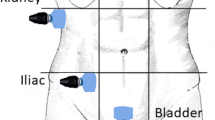Abstract
Objective
To determine the diagnostic performance of ultrasound for diagnosing ureteral calculi in children using a clinical effectiveness approach.
Methods
Billing records and imaging reports were used to identify children (≤ 18 years old) evaluated for suspected urolithiasis using ultrasound between March 2012 and March 2017. Patients without unenhanced CT within 24 h (reference standard) were excluded. Imaging (ultrasound and CT) reports were reviewed for presence, number, size, and location of calculi. Diagnostic performance of ultrasound (versus CT) was calculated on an individual ureter basis both by direct calculus visualization as well as direct visualization combined with suspected presence of ureteral stone based on indirect ultrasound findings.
Results
41 ureteral calculi were present in 38 of 69 (55.1%) patients. Mean patient age was 14.7 ± 3.6 years, and 35 of 69 (51%) patients were boys. Based on direct calculus visualization, ultrasound had a sensitivity of 12.8% (95% CI 5.6–26.7%), specificity of 100% (95% CI 96.3–100%), positive predictive value (PPV) of 100% (95% CI 56.6–100%), and negative predictive value (NPV) of 74.4% (95% CI 66.4–81.1%). When ultrasound examinations reported as suspicious for ureteral calculi based on indirect findings also were considered positive, ultrasound had a sensitivity of 41.0% (95% CI 27.1–56.6%), specificity of 95.0% (95% CI 88.7–97.8%), PPV of 76.2% (95% CI 54.9–89.4%), and NPV of 80.3% (95% CI 72.2–86.5%).
Conclusions
In clinical practice, ultrasound has low sensitivity for directly visualizing ureteral calculi subsequently identified by CT, although sensitivity improves when considering suspicious examinations as positive.



Similar content being viewed by others
References
Routh JC, Graham DA, Nelson CP. Epidemiological trends in pediatric urolithiasis at United States freestanding pediatric hospitals. J Urol 2010; 184:1100-1104.
Dwyer ME, Krambeck AE, Bergstralh EJ, Lieske JC, Rule AD. Temporal trends in incidence of kidney stones among children: a 25-year population based study. J Urol 2012; 188:247-252.
Dubinsky TJ, Sadro CT. Acute onset flank pain--suspicion of stone disease. Ultrasound Q 2012; 28:239-240.
Fulgham PF, Assimos DG, Pearle MS, Preminger GM. Clinical effectiveness protocols for imaging in the management of ureteral calculous disease: AUA technology assessment. J Urol 2013; 189:1203-1213.
Riccabona M, Avni FE, Blickman JG, Dacher JN, Lobo ML, Willi U. Imaging recommendations in paediatric uroradiology. Minutes of the ESPR uroradiology task force session on childhood obstructive uropathy, high-grade fetal hydronephrosis, childhood haematuria, and urolithiasis in childhood. Pediatr Radiol 2009; 39:891-8.
Gartlehner, G., et al., AHRQ Technical Reviews, in Criteria for Distinguishing Effectiveness From Efficacy Trials in Systematic Reviews. 2006, Agency for Healthcare Research and Quality (US): Rockville (MD).
Roberson NP, Dillman JR, O'Hara SM, DeFoor WR Jr, Reddy PP, Giordano RM, Trout AT. Comparison of ultrasound versus computed tomography for the detection of kidney stones in the pediatric population: a clinical effectiveness study. Pediatr Radiol 2018; 48:962-972.
BMI Percentile Calculator for Child and Teen. CDC website. https://nccd.cdc.gov/dnpabmi/calculator.aspx. Accessed July 1, 2017.
Niemann T, Kollmann T, Bongartz G. Diagnostic performance of low-dose CT for the detection of urolithiasis: a meta-analysis. Am J Roentgenol 2008; 191:396-401.
Park SJ, Yi BH, Lee HK, Kim YH, Kim GJ, Kim HC. Evaluation of patients with suspected ureteral calculi using sonography as an initial diagnostic tool: how can we improve diagnostic accuracy? J Ultrasound Med 2008; 27:1441-1450.
Ripolles T, Martinez-Perez MJ, Vizuete J, Miralles S, Delgado F, Pastor-Navarro T. Sonographic diagnosis of symptomatic ureteral calculi: usefulness of the twinkling artifact. Abdom Imaging 2013; 38:863-869.
Kanno T, Kubota M, Sakamoto H, Nishiyama R, Okada T, Higashi Y, et al. Determining the efficacy of ultrasonography for the detection of ureteral stone. Urology 2014; 84:533-537.
Mos C, Holt G, Iuhasz S, Mos D, Teodor I, Halbac M. The sensitivity of transabdominal ultrasound in the diagnosis of ureterolithiasis. Med Ultrason 2010; 12:188-197.
Moesbergen TC, de Ryke RJ, Dunbar S, Wells JE, Anderson NG. Distal ureteral calculi: US follow-up. Radiology 2011; 260:575-580.
Burge HJ, Middleton WD, McClennan BL, Hildebolt CF. Ureteral jets in healthy subjects and in patients with unilateral ureteral calculi: comparison with color Doppler US. Radiology 1991; 180:437-442.
Pichler R, Skradski V, Aigner F, Leonhartsberger N, Steiner H. In young adults with a low body mass index ultrasonography is sufficient as a diagnostic tool for ureteric stones. BJU Int 2012; 109:770-774.
Author information
Authors and Affiliations
Corresponding author
Ethics declarations
Conflicts of interest
All authors declare that they have no conflict of interest.
Additional information
Publisher's Note
Springer Nature remains neutral with regard to jurisdictional claims in published maps and institutional affiliations.
Rights and permissions
About this article
Cite this article
Roberson, N.P., Dillman, J.R., Reddy, P.O. et al. Ultrasound versus computed tomography for the detection of ureteral calculi in the pediatric population: a clinical effectiveness study. Abdom Radiol 44, 1858–1866 (2019). https://doi.org/10.1007/s00261-019-01927-2
Published:
Issue Date:
DOI: https://doi.org/10.1007/s00261-019-01927-2




